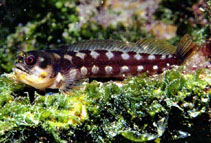Acanthemblemaria castroi Stephens & Hobson, 1966
Galapagos barnacle blenny
個人による観察記録の追加 Fish Watcher
| Native range | All suitable habitat | Point map | Year 2050 |

|
| This map was computer-generated and has not yet been reviewed. |
| Acanthemblemaria castroi AquaMaps Data sources: GBIF OBIS |
Common names from other countries
分類 / Names 共通名の | 類義語 | Catalog of Fishes(部類, 種) | ITIS | CoL | WoRMS | Cloffa
> Blenniiformes (Blennies) > Chaenopsidae (Pike-, tube- and flagblennies)
Etymology: Acanthemblemaria: Greek, akantha = thorn + Greek, emblema, -atos, anything that is nailed, knocked in; also anything with bass or high relief (Ref. 45335).
Eponymy: Miguel Castro was an Ecuadorian naturalist resident on the Galapagos Islands. He became (1960) the first conservation officer at the Charles Darwin Research Station, Academy Bay, Santa Cruz Island, Galapagos. (Ref. 128868), visit book page.
Etymology: Acanthemblemaria: Greek, akantha = thorn + Greek, emblema, -atos, anything that is nailed, knocked in; also anything with bass or high relief (Ref. 45335).
Eponymy: Miguel Castro was an Ecuadorian naturalist resident on the Galapagos Islands. He became (1960) the first conservation officer at the Charles Darwin Research Station, Academy Bay, Santa Cruz Island, Galapagos. (Ref. 128868), visit book page.
Environment: milieu / climate zone / depth range / distribution range 生態学
分布 国々 | 国連食糧農業機関の区域 | エコシステム | 事件 | Point map | 導入 | Faunafri
Southeast Pacific: endemic to the Galapagos Islands.
サイズ / 重さ / 年齢
Lives in empty barnacle shells. Often perches in the opening with only the head protruding. Seldom seen in the open. Darts out to nab bits of floating food (Ref. 5227). Oviparous (Ref. 56066). Eggs are attached to the walls of the parent's shelter and are brooded by the male parent (Ref. 56066).
Life cycle and mating behavior 成熟 | 繁殖 | 放精 | 卵 | 生産力 | 幼生
主な参考文献
Upload your references | 参考文献 | コーディネーター : Williams, Jeffrey T. | 協力者
Allen, G.R. and D.R. Robertson, 1994. Fishes of the tropical eastern Pacific. University of Hawaii Press, Honolulu. 332 p. (Ref. 11482)
IUCNのレッドリストの状況は (Ref. 130435: Version 2024-2)
攻撃されやすい (VU) (B2ac(iv); D2); Date assessed: 13 September 2022
人間に対する脅威
Harmless
Human uses
FAO(Publication : search) | FIRMS (Stock assessments) | FishSource |
より多くの情報
Trophic ecology
食品種目概要について
餌の構成
摂食量
Food rations
捕食動物
食品種目概要について
餌の構成
摂食量
Food rations
捕食動物
Ecology
生態学
Home ranges
生態学
Home ranges
Population dynamics
成長のパラメーター
Max. ages / sizes
Length-weight rel.
Length-length rel.
体長組成
Mass conversion
補充
豊度
成長のパラメーター
Max. ages / sizes
Length-weight rel.
Length-length rel.
体長組成
Mass conversion
補充
豊度
Anatomy
カマ
Brain
Otolith
カマ
Brain
Otolith
Physiology
Body composition
Nutrients
酸素消費
水泳形態
泳ぐ速さ
Visual pigments
Fish sound
Diseases & Parasites
Toxicity (LC50s)
Body composition
Nutrients
酸素消費
水泳形態
泳ぐ速さ
Visual pigments
Fish sound
Diseases & Parasites
Toxicity (LC50s)
Genetics
遺伝子の
Heterozygosity
遺伝
遺伝子の
Heterozygosity
遺伝
用具
E-book | 野外観察図鑑 | Length-frequency wizard | 生活史の基盤ツール | 目的のマップ | Classification Tree
| Catch-MSY |
特記事項
XMLをダウンロードして下さい
インターネットの情報源
Aquatic Commons | BHL | Cloffa | Websites from users | Check FishWatcher | CISTI | Catalog of Fishes(部類, 種) | DiscoverLife | ECOTOX | Faunafri | Fishtrace | GenBank(ゲノム, ヌクレオチド) | GloBI | GOBASE | | Google Books | Google Scholar | Google | IGFA World Record | MitoFish | Otolith Atlas of Taiwan Fishes | PubMed | Reef Life Survey | Scirus | SeaLifeBase | 生命の木 | Wikipedia(行く, 検索する) | World Records Freshwater Fishing | Zoobank | 動物に関する記録
Estimates based on models
Preferred temperature (Ref. 115969): 23.5 - 25.6, mean 23.8 (based on 20 cells).
Phylogenetic diversity index (Ref. 82804): PD50 = 0.5000 [Uniqueness, from 0.5 = low to 2.0 = high].
Bayesian length-weight: a=0.00525 (0.00219 - 0.01260), b=3.06 (2.85 - 3.27), in cm Total Length, based on LWR estimates for this (Sub)family-body shape (Ref. 93245).
栄養段階 (Ref. 69278): 3.4 ±0.5 se; based on size and trophs of closest relatives
Fishing Vulnerability (Ref. 59153): Low vulnerability (10 of 100).




